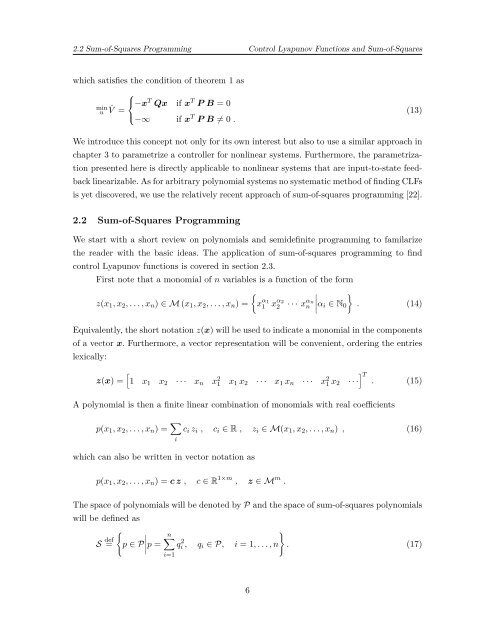Sum-of-Squares Applications in Nonlinear Controller Synthesis
Sum-of-Squares Applications in Nonlinear Controller Synthesis
Sum-of-Squares Applications in Nonlinear Controller Synthesis
- No tags were found...
Create successful ePaper yourself
Turn your PDF publications into a flip-book with our unique Google optimized e-Paper software.
2.2 <strong>Sum</strong>-<strong>of</strong>-<strong>Squares</strong> Programm<strong>in</strong>g Control Lyapunov Functions and <strong>Sum</strong>-<strong>of</strong>-<strong>Squares</strong>which satisfies the condition <strong>of</strong> theorem 1 asm<strong>in</strong>u ˙V =⎧⎨−x T Qx if x T P B = 0⎩−∞ if x T P B ≠ 0 .(13)We <strong>in</strong>troduce this concept not only for its own <strong>in</strong>terest but also to use a similar approach <strong>in</strong>chapter 3 to parametrize a controller for nonl<strong>in</strong>ear systems. Furthermore, the parametrizationpresented here is directly applicable to nonl<strong>in</strong>ear systems that are <strong>in</strong>put-to-state feedbackl<strong>in</strong>earizable. As for arbitrary polynomial systems no systematic method <strong>of</strong> f<strong>in</strong>d<strong>in</strong>g CLFsis yet discovered, we use the relatively recent approach <strong>of</strong> sum-<strong>of</strong>-squares programm<strong>in</strong>g [22].2.2 <strong>Sum</strong>-<strong>of</strong>-<strong>Squares</strong> Programm<strong>in</strong>gWe start with a short review on polynomials and semidef<strong>in</strong>ite programm<strong>in</strong>g to familarizethe reader with the basic ideas. The application <strong>of</strong> sum-<strong>of</strong>-squares programm<strong>in</strong>g to f<strong>in</strong>dcontrol Lyapunov functions is covered <strong>in</strong> section 2.3.First note that a monomial <strong>of</strong> n variables is a function <strong>of</strong> the form{}z(x 1 , x 2 , . . . , x n ) ∈ M (x 1 , x 2 , . . . , x n ) = x α 11 xα 22 · · · x αnn ∣ α i ∈ N 0 . (14)Equivalently, the short notation z(x) will be used to <strong>in</strong>dicate a monomial <strong>in</strong> the components<strong>of</strong> a vector x. Furthermore, a vector representation will be convenient, order<strong>in</strong>g the entrieslexically:z(x) =[1 x 1 x 2 · · · x n x 2 1 x 1 x 2 · · · x 1 x n · · · x 2 1 x 2 · · ·] T. (15)A polynomial is then a f<strong>in</strong>ite l<strong>in</strong>ear comb<strong>in</strong>ation <strong>of</strong> monomials with real coefficientsp(x 1 , x 2 , . . . , x n ) = ∑ ic i z i , c i ∈ R , z i ∈ M(x 1 , x 2 , . . . , x n ) , (16)which can also be written <strong>in</strong> vector notation asp(x 1 , x 2 , . . . , x n ) = c z , c ∈ R 1×m , z ∈ M m .The space <strong>of</strong> polynomials will be denoted by P and the space <strong>of</strong> sum-<strong>of</strong>-squares polynomialswill be def<strong>in</strong>ed as{S defn }= p ∈ P∣ p = ∑qi 2 , q i ∈ P, i = 1, . . . , n . (17)i=16













